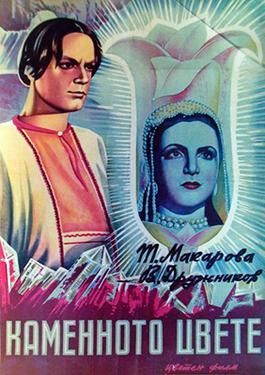On 28 April 1946, The Stone Flower, a Soviet fantasy film directed by Aleksandr Ptushko, an adaptation of Pavel Bazhov's story of the same name based on Russian Ural region folklore, was released in Soviet cinemas. The legend of Danilo the Craftsman and the Mistress of the Copper Mountain was filmed in liberated Czechoslovakia, using the capacity and advanced technology of Barrandov Studios.
Colour films in the Soviet Union up to 1945 had been shot with modest results – on technicolour three-strip cameras and then spliced together. The Germans, on the other hand, had been using triple-layer Agfacolor (Agfa) colour film since 1925. When the IG Farben plant in Greppin ended up in the Soviet Occupation Zone, the filmmakers obtained a trophy of equipment and stocks of Agfa film. The first director entrusted to use it was Alexander Ptushko. They decided to shoot a vivid and impressive tale - the people, exhausted by the hardships of war, were in dire need of such a gift.
The visual solutions were sought in the subjects of The Itinerants and Russian historical paintings, while the underworld was invented by studying the collections of the Museum of Geology and Mineralogy of the Academy of Sciences of the USSR. Costume designer Olga Kruchinina designed unique colour palettes and selected fabrics using pre-war stocks from Barrandov Studios. The shooting of the film in Czechoslovakia took place not only in pavilions, but also at a nature reserve, producing a harmonious balance between artificial crystals and real cave stalactites and stalagmites.
The film, starring Vladimir Druzhnikov and Tamara Makarova, created a sensation, instantly receiving public acclaim and becoming a box-office leader with over 23 million viewers. The Stone Flower was shown in France, Finland, Sweden, and the United States. In October 1946, the picture received the prize for Best Colour at the Cannes Film Festival. Soviet newspapers reprinted reviews from the foreign press: even the sophisticated Americans agreed that the Soviet colour film deserved the highest praise.
In the 1950s, more than a hundred more pictures would be shot in the USSR with the trophy Agfa film stocks. The dismantled equipment from the German plants would be transported to Kazan, where the production of Soviet Tasma film would be set up.
Sources:
The newspaper “Vechernyaya Moskva”, No. 98 from 25 April 1946, No. 2 from 2 January 1947
























